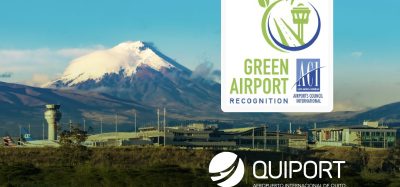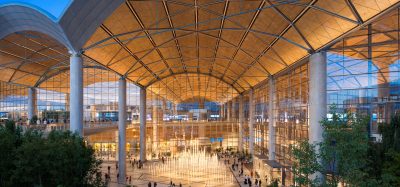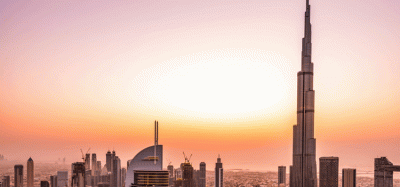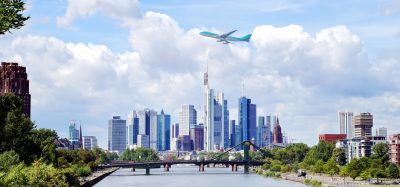Munich Airport’s environmental strategy
Posted: 3 December 2008 | Matthias Linde, Project Manager for Sustainability at Munich Airport | No comments yet
Ecological sustainability has traditionally been a key element in Munich Airport’s environmental strategy and policy, and will become increasingly important in the future as the airport continues to pursue initiatives, not only in the form of innovative environmental projects.
Ecological sustainability has traditionally been a key element in Munich Airport’s environmental strategy and policy, and will become increasingly important in the future as the airport continues to pursue initiatives, not only in the form of innovative environmental projects.
More than 60% of Munich’s 1550 hectares are green areas, and FMG, the Munich Airport operating company, has purchased and set aside further tracts of woodland and wetlands in the immediate airport region as conservation areas, to compensate for the areas paved over when the airport was built. In the 1990s, Munich Airport became the first airport worldwide with a hydrogen fuelling station for apron buses and other vehicles. The pilot research project, funded by the State of Bavaria, was successfully completed in late 2006.
In 2005 Munich Airport received environmental certification under EMAS (Eco Management and Audit Scheme) and DIN ISO 14001, which demonstrates Munich Airport’s relentless commitment to go above and beyond environmental regulations, set at the EU and national level, mandating environmental protection standards at airports. The focus is now on establishing new and streamlining existing sustainability measures at Munich Airport in line with certification standards. Certification under the ISO 14001 and EMAS standards was successfully renewed this year and remains a key element in FMG’s environmental strategy.
Environmental protection encompasses many different aspects at the Bavarian hub. For example, Munich operates a fee policy to encourage the use of quieter aircraft, assigning aircraft types to noise categories based on take-off and landing measurements (the quietest jets being eight times less noisy than their counterparts). A ‘hush house’ (engine testing hangar) has also been built for the necessary post-maintenance engine test runs, and continual noise level measurements are carried out for the nearby residential areas.
The airports in Munich and Frankfurt have launched pilot projects to introduce an emissions-linked component in their take-off and landing fees. The new fee structure takes into account the quantity of nitrous oxide and hydrocarbon emissions of individual aircraft. The overall effect of this change will be to encourage airlines and aircraft manufacturers to redouble their efforts to develop and invest in modern aircraft, that are generally more ecologically efficient. Emission-based fees create an incentive for airlines to operate aircraft with the lowest possible NOx emissions, and send a signal to manufacturers to forge ahead with technological innovation to improve environmental efficiency.
The biggest environmental issue for any company, and that goes for FMG as well, is climate change and the related greenhouse gas emissions. At FMG the reduction of CO2 emissions is treated as a top priority. An analysis of emissions was carried out to identify the largest sources and a follow-up assessment is now being carried out to determine where the fastest CO2 reductions can be achieved. The potential measures that can be taken will be identified by the end of 2008 and added to the list of measures under the FMG environmental management programme.
The airport buildings account for the largest share of the energy used by the airport operating company. When developing measures to achieve improvements, the optimisation of buildings will play a major role. New buildings now in planning, such as the satellite terminal, are being designed to consume less energy than existing ones.
The vehicle fleet accounts for a smaller share in the emissions. However, FMG has also been making efforts for some time now to run the fleet with alternative fuels, including canola oil to replace diesel fuel and ethanol as a substitute for gasoline. Also under consideration is the use of natural gas containing a certain percentage of bio-gas.
Equally important are efforts to raise awareness of environmental issues on the airport campus. To achieve this goal, FMG has begun evaluating and certifying its subsidiaries in terms of environmental standards. It is also offering to sell the available alternative fuels to any companies on the airport campus interested in doing their part to reduce greenhouse gas emissions.
For the airport’s energy supply, FMG took a trailblazing approach right from the time the airport was built, installing a combined heat and power plant that meets half of Munich Airport’s needs for power, heat and cooling, at an efficiency level of better than 80%. It is operated to a large extent with natural gas, instead of heating oil, which in turn helps to reduce CO2 emissions.
Another pioneering development is the solar power installation placed on the roof of Munich Airport’s Terminal 2, which, when the terminal went into operation in 2003, comprised the world’s largest such installation at a commercial airport. It generates enough power each year to sustain around 155 households, and will reduce CO2 emissions by around 12,000 tonnes over its 30-year lifespan. Future projects include the use of bio-gas or biomass-generated energy and the renovation of campus buildings to improve insulation.
The airport is also in the process of patenting a special technique, developed at Munich Airport, for ensuring that groundwater supplies stay pollution free. The patent is for a filter that is the first of its kind worldwide, a biological water filter that expedites the chemical breakdown of non-hazardous waste products and biodegrades them 100% to fully eliminate their environmental impact.
Further measures range from the reduction of office paper waste, an optimised work-flow system and a move towards ‘paperless offices’, to replacing office equipment such as computers with energy-saving models that save up to 50% in energy consumption.
Yet another innovative element in Munich Airport’s environmental protection initiatives: cabbage! Drivers on the way to the airport might notice what look like flower pots balanced on the top of poles alongside the road: This is part of Munich Airport’s ongoing ‘biomonitoring’ of airport-generated emissions. The pots contain plants such as cabbage and kale. To see how they’re affected by airport emissions they are ground up in a lab to measure pollution levels. These plants are exposed to a wide range of pollutant sources (traffic, industrial processes, agriculture and other combustion facilities) that emit contaminants into the surrounding air. Nevertheless, the test results from the vicinity of the airport showed similarly low levels to those found at measurement stations in Bavaria, at locations far removed from pollutant sources.
In 2008 FMG announced a cash award for innovative ideas to reduce the environmental impact of air transportation. The ‘MUC Award’ is intended to foster research initiatives in the fields of noise protection, clean air, clean and climate-friendly energy production, and sustainability. Projects submitted by students and young university researchers will be assessed by a jury comprised of representatives of the scientific community, the aviation industry and the press. The winner of the award, which will be granted every two years, will receive 10,000 Euros.
Sustainability involves more than just environmental issues however. Through its human resources policies, FMG also acts as a good corporate citizen by supporting its employees in many different areas. These include the company’s health management program, which encourages employees to become more physically active and make healthier food choices, and continuing education courses for a very diverse range of target groups.
At present, in September 2008, a programme of health-related events is taking place to point the way to better lifestyles. This includes onsite testing of various health parameters, nutrition consultation and demonstrations of a number of sports offered by the FMG’s own sports club or external partners.
As in the past, FMG will continue to act in the interests of its employees to retain its status as an attractive employer facing modern challenges and offering solutions.
Within the framework of its sustainability project, FMG also wishes to become active in the area of corporate responsibility (CR). By joining the Global Compact and making a commitment to the 10 underlying principles, FMG is enhancing its standing as a good corporate citizen and accepting the obligation to subject its own activities to an ongoing critical assessment.
FMG plans to publish a sustainability report in the summer of 2009. In addition to reporting on measures in this area, it will also outline how FMG integrates sustainability issues into its strategies and its management approach.
As for sustainable growth in the economic sense, Munich Airport’s future will largely be determined by its ability to maintain its status as an expanding European aviation hub. Since the beginning of the hub development in Munich in the mid-1990s, the airport has steadily moved up in the rankings of Europe’s busiest airports in terms of passenger volume, and in 2007 reached the number seven position among the top ten.
One of the most crucial factors for the continued growth of Munich Airport is the plan for a third runway. According to current forecasts, annual passenger volume in Munich will increase from 34 million today to 57 million by 2020. During the same period, take-offs and landings are projected to increase from 430,000 to more than 600,000.
With its two existing runways, which permit the handling of up to 90 schedulable aircraft movements per hour, Munich Airport already operates at close to full capacity during the greater part of each operating day. The traffic increases described in the forecast would far exceed the limits of today’s capacities. Consequently, FMG is currently planning to build a third runway that would increase the capacity for schedulable take-offs and landings to 120 per hour.
A high priority in the ongoing development plans, is limiting or compensating for the impact of airport expansion on the environment and the airport region. The environmental impact was one of the decisive criteria when selecting the possible location for the third runway for instance. When the planning activities began, a Regional Advisory Council was formed in which representatives of the airport region can express their interests in connection with the expansion process. The council addresses measures and projects that can be sponsored with the resources of the FMG compensation fund. This fund, with a volume of approximately 100 million Euros, was set up at the instigation of the airport operating company to provide compensation beyond the legal requirements, in case of particular hardships related to the third runway.
With its decisive efforts to expand capacity, in response to rising demand for air transportation, Munich Airport is helping to avoid traffic bottlenecks on the ground and in the air, and hence to limit the environmental damage they cause. The further development of the Munich air transportation hub is also welcome in terms of efficient traffic management – because only the continued availability of high-performance hubs in the future will ensure that international air traffic can be bundled and distributed exactly where and when it is needed. Efficient hubs are thus crucial to improving load factors of aircraft and keeping the number of point-to-point flights within the limits of what is necessary.
Join our free webinar: Transforming Airport Security – Innovation, Impact, and the Passenger Experience
The landscape of airport security is undergoing a profound transformation, driven by evolving threats, technology, and passenger expectations. This webinar focuses on how AtkinsRéalis has been transforming security processes at some of the world’s busiest airports with smarter, more adaptive solutions.
Date: 4 Nov | Time: 14:00 GMT
REGISTER NOW TO SECURE YOUR SPOT
Can’t attend live? No worries – register to receive the recording post-event.

















